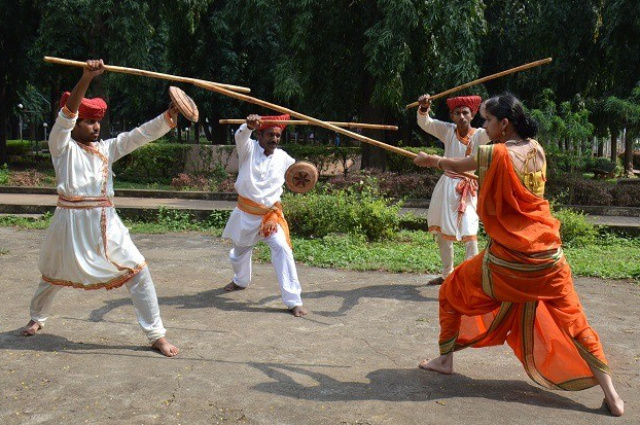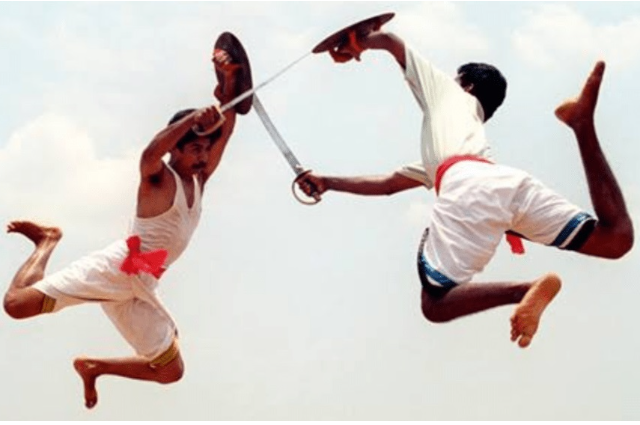
Indians are familiar with many sports forms; be it kabaddi, hockey, cricket, swimming, tennis, or squash. Apart from these popular sports, India is also home to various martial arts like wrestling, combat fighting, and sword fighting. India’s association with these martial arts can be traced to 1500 BCE when the earliest accounts of combat fighting find a mention in the Dhanurveda. Mallayuddha (wrestling), Mushtiyuddha (boxing), Dhanurvidya (archery), and Khadagvidya (swordsmanship) were most often used in combats between warring armies.
Today, all these combat forms have grown from their origin and are being played at the highest competitive levels the world over. Sword Fighting is one such sport that is popular across the world, with every country displaying varied adaptations. Within India itself, every region has adapted sword fighting to reflect the ethos, culture, and tradition of the land. From north to south, east to west, the form and structure vary, highlighting the cultural diversity of India.
Sword fighting in India, despite being centuries old, is losing popularity amongst today’s youth. These are a few of the sword-fighting arts of India, which unfortunately have become a dying art today with very few people showing interest in learning it. Instead of martial art, these have now taken the form of performing arts.
MARDANI KHEL
A martial art form practiced by Marathas in Maharashtra around the 1600s.

- HISTORY:
It flourished under Chhatrapati Shivaji Maharaj’s rule as they extensively used it in their wars against Mughals. Mardani Khel means, a sport played by men, and interestingly contrary to the meaning, both men and women play this sport. A few of the most famous proponents of this sport are Tanaji Malusare, Murar Baji, Baji Prabhu Rani, Lakshmi Bai, and Tara Bai, of the Maratha kingdoms. This martial art form saw a decline with colonial rule over India.
- TECHNIQUE:
Though many weapons like lathi (stick), dhala (circular shield), bhala (spear at the end of a stick), bharcha (short spear), etc are used, Pata and Talwar are the most important. Pata is a sword with a hollow handle acting as a hand-guard and Talwar is a curved single-edge sword. Dhop, Gurj, Khanda are the other kinds of swords that are straight, long, and heavy.
There is an extensive emphasis on strength training and agility, by focusing on Surya-namaskar, push-ups, and sit-ups. Initial training starts with a lathi (stick), and on gaining expertise, one moves on to swords.
The weapons are customized according to the fighter’s height and weight. There is a strict dress code that needs to be adhered to. Women wear lugda or kashta, (nine-yard saree tied in a dhoti style), while men wear mandchol (a thigh-length tunic with knee-length breeches underneath).
KATHI SAMU
A combat sport that originated as a warfare technique in Andhra Pradesh.

- HISTORY:
There are various stories behind the origin of this martial art form. Some believe it has originated during the war between devas and asuras; while some owe its knowledge to rishis who taught this to their disciples. This martial art developed in the areas of Vizianagaram and Karvetinagaram in Andhra Pradesh. The Pericheddi dynasty played an important role in its spread. With time, the Cholas, Chalukyas, Vijayanagara, and Bahmani empires influenced the techniques and spread of Kathi Samu.
East India Company’s arrival negatively affected this martial art, and the Britishers suppressed it. Zamindars, the local landlords, surreptitiously continued to develop this art, and today descendants of the erstwhile royal armies continue to practice it.
- TECHNIQUE:
The initial training starts with stick fighting known as vairi or karra samu. Adugu (footwork), simmu (using hands to swing the stick), palti (jumping and flipping oneself mid-air), dummi (hop) form part of the training.
Skilled fighters can fight with 2 swords in each hand (gareja) Dal farri khadga–two people holding swords and shields. Various kinds of swords–straight, curved, pata (sword with a wooden cover) are used in this martial art. Historically, only males used to take part, though now even females are learning this sport.
THANG TAA
It is the traditional martial art of Manipur, created by the Meitei tribes. Swords, spears, and daggers are the principal weapons used in this art, along with an emphasis on body movement. In Metei Language, Thang Taa is known as Huyen langlon, which means a method of safeguarding.

- HISTORY:
King Punshiba in the 14th century created a permanent army of warriors and trained them in the usage of swords and spears to fight their enemies. The warring parties adhered to strict rules, and the duel between the warriors would end once the first blood was drawn. It was customary to take the head of the defeated person as a trophy.
- TECHNIQUE:
The training starts with footwork and stepping patterns, and then basic sword strikes. There are different sword stances, postures, bare-handed techniques, and sparring techniques. Experts in Thang-Ta also practice Sarit-Sarat, a duel without the use of weapons.
The focus is entirely on handwork and footwork. Ningsha kanglon (breathing exercises), hirikonba (meditation), layeng kanglon (traditional medicines), and thengouron (sacred dances) are other important aspects of this traditional martial art.
PAIKA AKHARA AND PARI PHARI KHANDA
Paika Akhara is a traditional martial art that originated in Jharkhand. An extension of Paika is Pari Phari Khanda which is popular in Saraikela and Singhbum, tribal regions of Jharkhand.

- HISTORY:
Paika Akhara originated during the reign of King Kharavela, who ascended the throne of Kalinga. Established as an extension of the army, Paika flourished the most under King Gajapathy. Farmers trained in paika were the secret expansion of the King’s army. The king rewarded them with land in recognition of their participation in the wars. Pari Khanda developed from Paika Akhara. Pari means shield, and khanda means sword.
Raja Darp Narayan Singh, a Rajput king, established the Singhbum dynasty in the 12th century in the tribal regions of Jharkhand. He inducted the local tribesmen into his army and trained them as warriors. Pari Khanda flourished the most between the 17th-19th century.
- TECHNIQUE:
There is immense focus on strength, agility, and warfare. Dand baithak (squat), dand (push up), and 16 more kinds of body exercises like cart-wheel, etc. are part of the warm-up. The initial training starts with a bamboo or cane stick before using weapons like khanda (straight sword), dand patta (straight sword with a guard that covers the area between fist and middle of the arm), talwar (curved sword), do dhari, vakrakar, aayatkar, vargakar, etc.
In Pari-Khanda, there is a lot of emphasis on foot movement, body movement, and sword action. These are mainly learned from imitating the behaviour of birds and animals.
In the recently held Khelo India Youth Games 2021, Thang Taa along with Gatka (Punjab), Mallakhamb (Madhya Pradesh), and Kalaripayattu (Kerala) were part of the events to promote indigenous martial arts.
There is no dearth of martial arts in India. Kuttu varisai, Aki Kitti, Sqay, Silambam are a few more traditional combat sports that need revival and recognition. It is the responsibility of the government and the citizens to put in efforts to keep these traditional sports alive.
